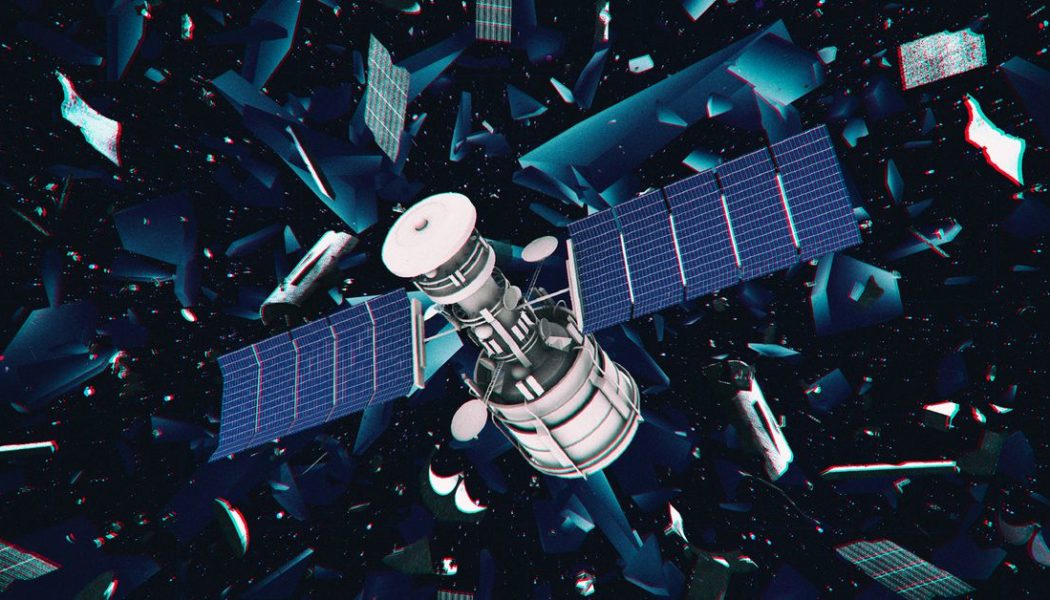
This morning, Russia destroyed one of its own satellites with a ground-based missile, creating thousands of pieces of debris that have spread out into Earth orbit, according to the US State Department. The US has identified at least 1,500 trackable pieces of debris from the event, and many thousands of smaller ones that cannot be traced, Ned Price, a spokesperson for the State Department, said during a briefing.
The news comes amid reports from Russia’s space agency Roscosmos, independently verified by The Verge via NASA’s live feed, that the astronauts living on board the International Space Station had to shelter in place this morning due to a cloud of space debris that seems to be passing by the station every 90 minutes, the time it takes for the ISS to orbit the Earth. NASA has yet to confirm if the debris field passing the ISS is the same one created by the Russian anti-satellite, or ASAT, test, and the agency did not immediately respond to a request for comment.
However, the State Department indicated that the debris field is a danger to the space station. “This test will significantly increase the risk to astronauts and cosmonauts on the International Space Station, as well as to other human spaceflight activities,” Price told reporters. “Russia’s dangerous and irresponsible behavior jeopardizes the long term sustainability of our space and clearly demonstrates that Russia’s claims of opposing the weaponization of space are disingenuous and hypocritical.”
US Space Command, which oversees the tracking of space objects and debris in orbit around Earth, told The Verge in a statement that it was “aware of a debris-generating event” in space this morning.
“We are actively working to characterize the debris field and will continue to ensure all space-faring nations have the information necessary to maneuver satellites if impacted,” US Space Command said in a statement. “We are also in the process of working with the interagency, including the State Department and NASA, concerning these reports and will provide an update in the near future.”
US Space Command has been tracking ASAT tests from Russia over the last couple of years. In 2020, US Space Command reported two tests of Russia’s ASAT technology, known as Nudol. However both tests did not seem to actually destroy any targets in space.
With new data from Kiwi Space Radar gathered at 1620 UTC, we confirm detection of multiple objects near expected location of Cosmos 1408. We will share supporting data as we gather it today.
— LeoLabs, Inc. (@LeoLabs_Space) November 15, 2021
Private space tracking company LeoLabs confirmed on Twitter that it has observed multiple objects are now in the location of an old Russian satellite called Kosmos 1408, which was rumored to be the target of the ASAT test. If that is the case, it seems likely that the debris cloud created from the test is the same one that threatened the International Space Station this morning, according to space tracking expert Jonathan McDowell.
During NASA’s live feed recording from the International Space Station this morning, mission controllers in NASA’s Johnson Space Center in Houston discussed the cloud of debris passing by the astronauts. “We are a minute and a half from the next debris field transit at this point,” a mission controller said to the astronauts, according to audio from the live feed recorded by Space.com. “This is going to be a four-minute transit.”
During the first few debris passes this morning, NASA astronauts sheltered inside the SpaceX Crew Dragon currently docked with the ISS, which just brought four new astronauts to the space station last week. However, the astronauts eventually opened the hatch to their vehicle and entered the ISS, according to the live feed audio.
Jonathan McDowell, an astrophysicist at Harvard and satellite tracker, calculated the time of the first debris field pass, which occurred around 2:06AM ET this morning. He found that the passes have occurred roughly every 93 minutes since that first pass. After figuring out the orbit of Kosmos 1408, he found that the paths of the satellite and the ISS do come close to each other every hour and a half.
Here is the orbit of ISS (blue) compared to that of the Ikar No. 39L satellite (cover name Kosmos-1408) (magenta) and the part of the orbit where the crew have been warned of possible collisions with a debris field (red). This shows Kosmos-1408 is a plausible candidate pic.twitter.com/oGJtQxWxkV
— Jonathan McDowell (@planet4589) November 15, 2021
“What I showed was that the orbital plane of this satellite actually is right through the part of the ISS orbit where they’re getting these warnings,” McDowell tells The Verge.
ASAT tests are often considered political moves that showcase a nation’s capability of taking out satellites. But they are a source of concern for those in the space industry, because of their propensity to cause giant fields of satellite fragments. These fields of debris can span many miles, jumping into higher and lower altitudes. The resulting debris pieces often vary wildly in size, and they can sometimes stay in orbit for years, threatening functioning satellites. Objects in low Earth orbit are moving at roughly 17,500 miles per hour, so if a fragment of space debris collides with another fast-moving satellite, it can cause significant damage or even create more fragments that then threaten other satellites.
China famously conducted an ASAT test in 2007, using a kinetic missile to destroy its Fengyun 1C satellite. The event created thousands of pieces of debris, some of which are still circulating above Earth. In fact, the International Space Station had to boost its orbit last week to avoid one of the fragments from the satellite still in orbit. In 2019, India also conducted its own ASAT test, known as Mission Shakti, creating hundreds of debris pieces after taking out a decaying satellite.
The United States also conducted an ASAT test in 2008, known as Operation Burnt Frost. The US military destroyed a satellite launched by the National Reconnaissance Office that was falling out of orbit. The satellite’s fuel tank contained more than 1,000 pounds of a toxic fuel called hydrazine, and the ASAT test was considered a way to protect people on the ground while exercising anti-satellite technology.
The US State Department is strongly condemning today’s ASAT test by Russia, calling it “dangerous, reckless, and irresponsible.” Price of the State Department did not say exactly what the US’s response would be, however. “[We] don’t telegraph specific measures, but as I said before, we will work with our allies and partners in different ways to make clear that the United States — that the international community — is not going to tolerate this kind of irresponsible behavior,” he said during the briefing.
Developing…









